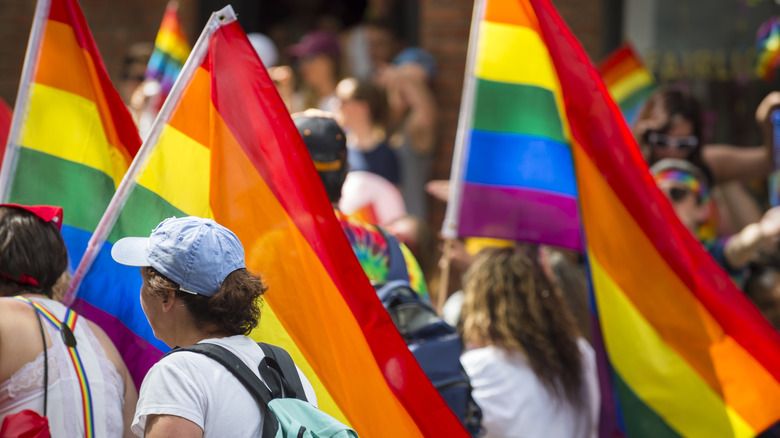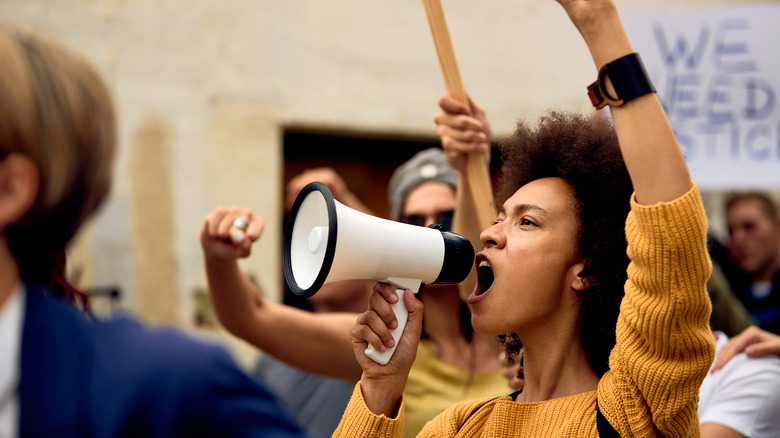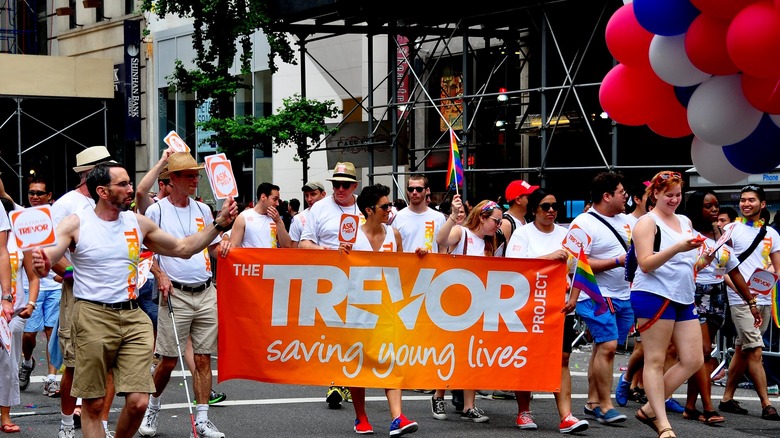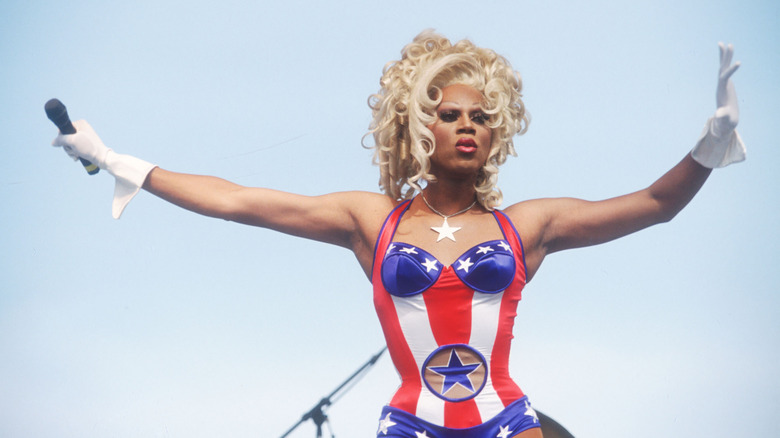5 Ways To Celebrate Pride Month Without Going To A Parade
We may receive a commission on purchases made from links.
June is a month of joy, reflection, and mourning for the greater LGBTQ+ community as it honors the anniversary of the Stonewall riots, which began on June 28th, 1969. That night, a police raid of the Stonewall Inn was intercepted by patrons and locals, demonstrating the collective strength and resilience of New York City's queer and trans community. The following year, the Christopher Street Liberation Day March took place on June 28th in New York, Chicago, San Fransisco, and Los Angeles (per The New York Times). With June established as a key signifier in LGBTQ+ history, Pride parades, marches, and festivals now take place all over the country and have become popular internationally.
Though Pride month is a time for celebration, it is more important than ever to research new legislation that threatens the mental and physical well-being of millions of young people in America. Ensuring that every LGBTQ+ youth has at least one accepting adult in their life is a vital step that The Trevor Project identifies as crucial to saving lives. But in the midst of an ever-evolving pandemic it can be difficult to know how to support the cause when showing up physically or attending a parade is not always an option.
Whether someone identifies as a member of the community, an ally, or an outsider hoping to learn more, supporting queer and trans youth requires immediate attention and action. Fortunately, there are a multitude of ways to support the queer community from afar; taking action during Pride is an especially meaningful contribution.
1. Contact your representatives
Goodgoodgood recommends reaching out to elected officials and provides avenues for emailing, writing letters, calling, and even texting. To get in contact with your elected officials, you can call this phone number — 1-844-USA-0234 (1-844-872-0234) — and even use messaging tools available on the White House's website. To find your local representatives, Common Good has an easy search tool that allows you to review bills officials have introduced, causes they are involved in, and lists of their campaign contributors.
The organization goodgoodgood provides information on new and existing bills that will affect trans youth and written scripts for anyone unsure of how to address these issues with officials over the phone or via email. Step Up also has a search tool for finding anti-trans legislation and is helpfully categorized by state.
2. Donate to organizations that support protective legislation and education
Out Of Yer Shell is an active database that provides donation links for a broad range of organizations that fight on behalf of LGBTQ+ youth and research on how to support trans and gender non-conforming youth. The Trans Youth Equality Foundation is also an excellent educational resource for families, educators, and youths to learn more about the LGBTQ+ experience and avenues for advocacy.
Accessing resources can be as easy as following Trans Youth Equality on Instagram, where they even provide empowering coloring worksheets for LGBTQ+ kids and affirming classroom posters for educators. Gender Spectrum, an organization that provides training for professionals in the educational, medical, and mental health fields, also provides a Gender-Inclusive Toolkit that can make a difference in the classroom and beyond.
3. Support queer artists
Go to your local coffee shop and check out the art on the walls, look for queer artists via Instagram hashtags, or look up Twitter threads. Read about nonprofits like Queer Art, which matches artists with mentors and donors, organizes digital book and print fairs, and funnels 100% of the funds raised back to creators.
The Met suggests a few queer artists and exhibits that deserve public attention, and its online catalog at the Thomas J. Watson Library is a comprehensive database for finding new artistic inspirations. Supporting local queer-owned businesses and scouring the internet for creators beyond Etsy — since the company is able to retain a larger share of profits — can be an excellent way to give back to a creative and industrious community that has given the world so much.
4. Get a refresher on LGBTQ+ history
Crack open a nonfiction book on LGBTQ+ history or catch a documentary like "Disclosure" that features transgender celebrities and activists in honor of Pride. When consuming stories about the queer community, however, it is crucial to acknowledge the source of the work and whether the production process was an ethical one.
In the case of "Paris is Burning," one of the most acclaimed documentaries of its kind, the narrative focused on the ballroom community in New York City and features gifted drag performers and their house families. However, the film was shot by Jennie Livingston, a filmmaker completely removed from the scene, and it has been accused of capitalizing off of the ballroom community's stories without compensating participants on an adequate scale. Miramax reportedly paid participants $55,000 split 13 ways, while the film raked in $4 million (per Vanity Fair).
Questions of ethically-minded consumption also rose up around "Happy Birthday, Marsha!" on Amazon, a brief but powerful documentary short focused on the life of legendary trans activist, Marsha P. Johnson. After the success of Netflix's "The Death and Life of Marsha P. Johnson," one "Happy Birthday, Marsha!" co-creator spoke out about material and sources she believed were duplicated from their film. Tourmaline, a black trans woman and filmmaker dedicated to chronicling the lives of legendary activists, expressed this via Instagram. However, the other film's director, David France, denied the claim via Twitter.
5. Celebrate pride in your own way
As a member of the LGBTQ+ community, it can feel isolating to not attend large-scale pride events, but there are still plenty of ways to feel proud. Especially considering those who are not out or feel unsafe expressing their identity in their home communities, it is vitally important to connect to the greater queer community however possible. This could mean listening to queer musicians who communicate unabashed queer joy through their lyrics — like Lil Nas X or Hayley Kiyoko, watching television shows with characters on journeys with gender or sexuality — like "Heartstopper" on Netflix, or just looking for the brighter spots on the internet.
For the person with less viewing freedom, Netflix has a feature that allows users to hide their viewing history, in case a shared account puts that person at risk.
For subtle expressions of queerness, Vice suggests bringing back old-school pride symbols — like the Greek letter Lambda (λ) or repping your favorite colored stripe from the pride flag.
Unfortunately, queer and trans folks make up a disproportionate percentage of the prison population in America for a range of reasons, per Vox (with more statistics available via Map.org). To reach out to these isolated community members, Black and Pink has a program for sending letters to incarcerated penpals.
However you celebrate, it's important to remember that you're part of something greater, and, though we may be far apart, you're never truly alone.





